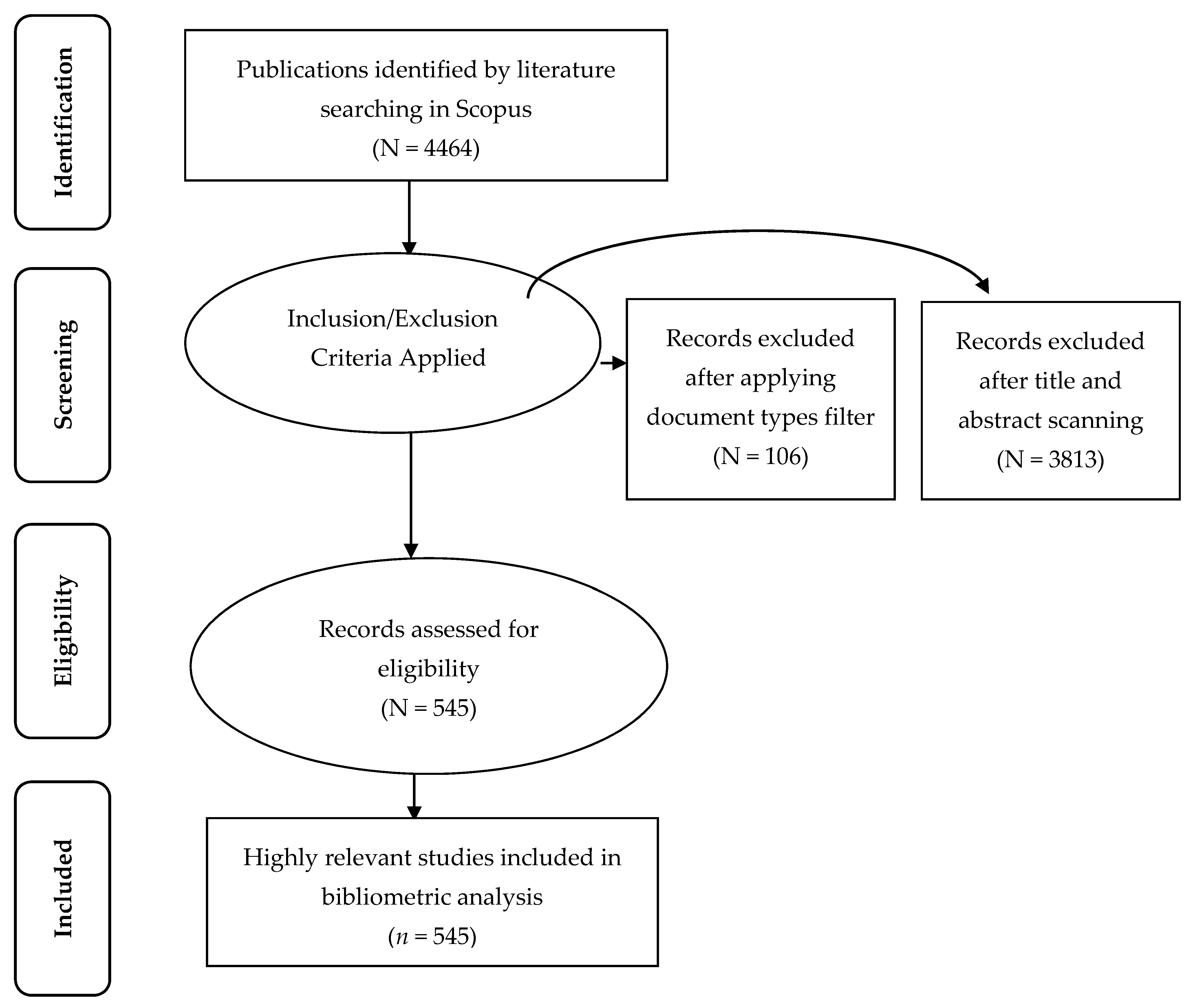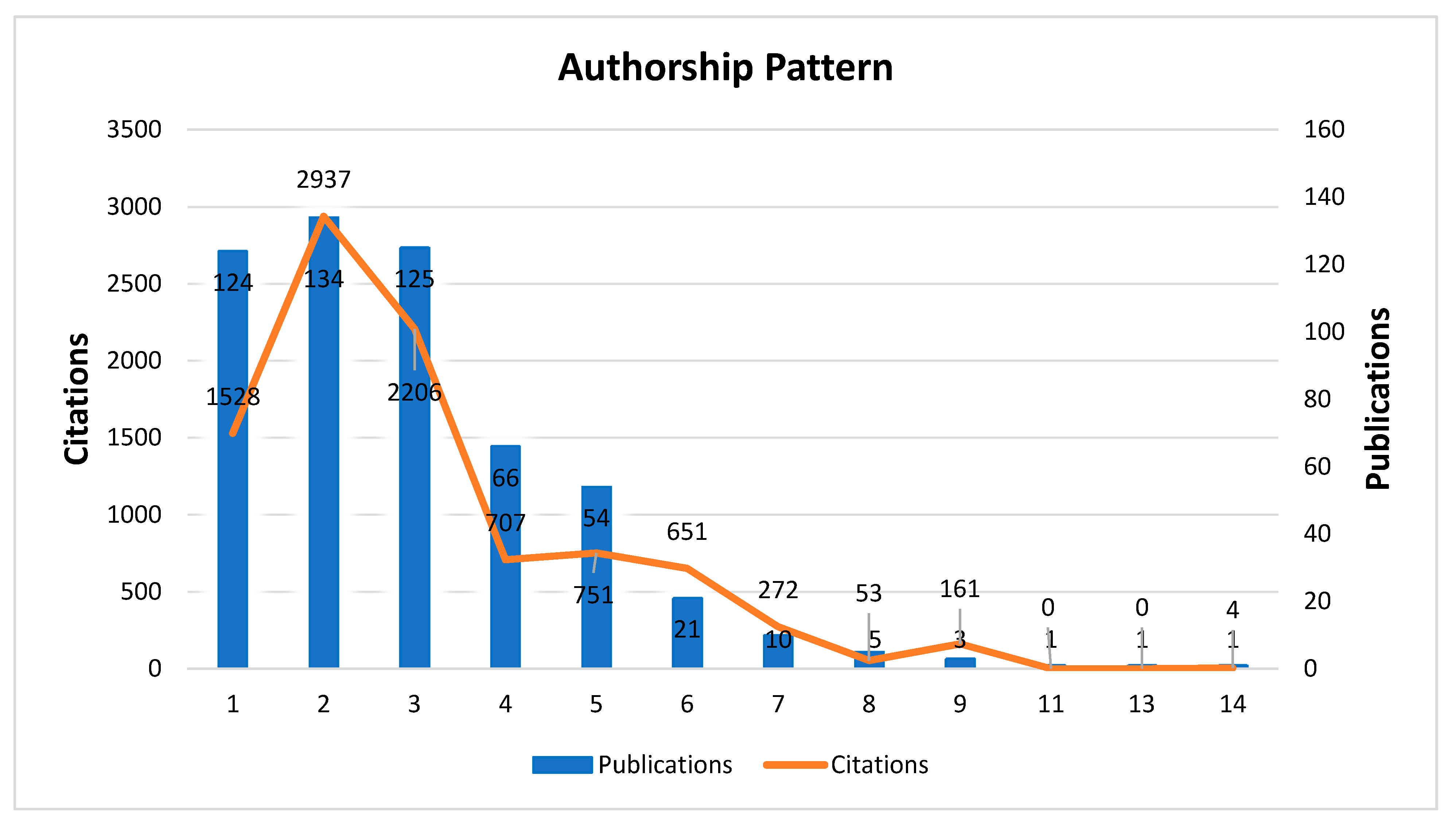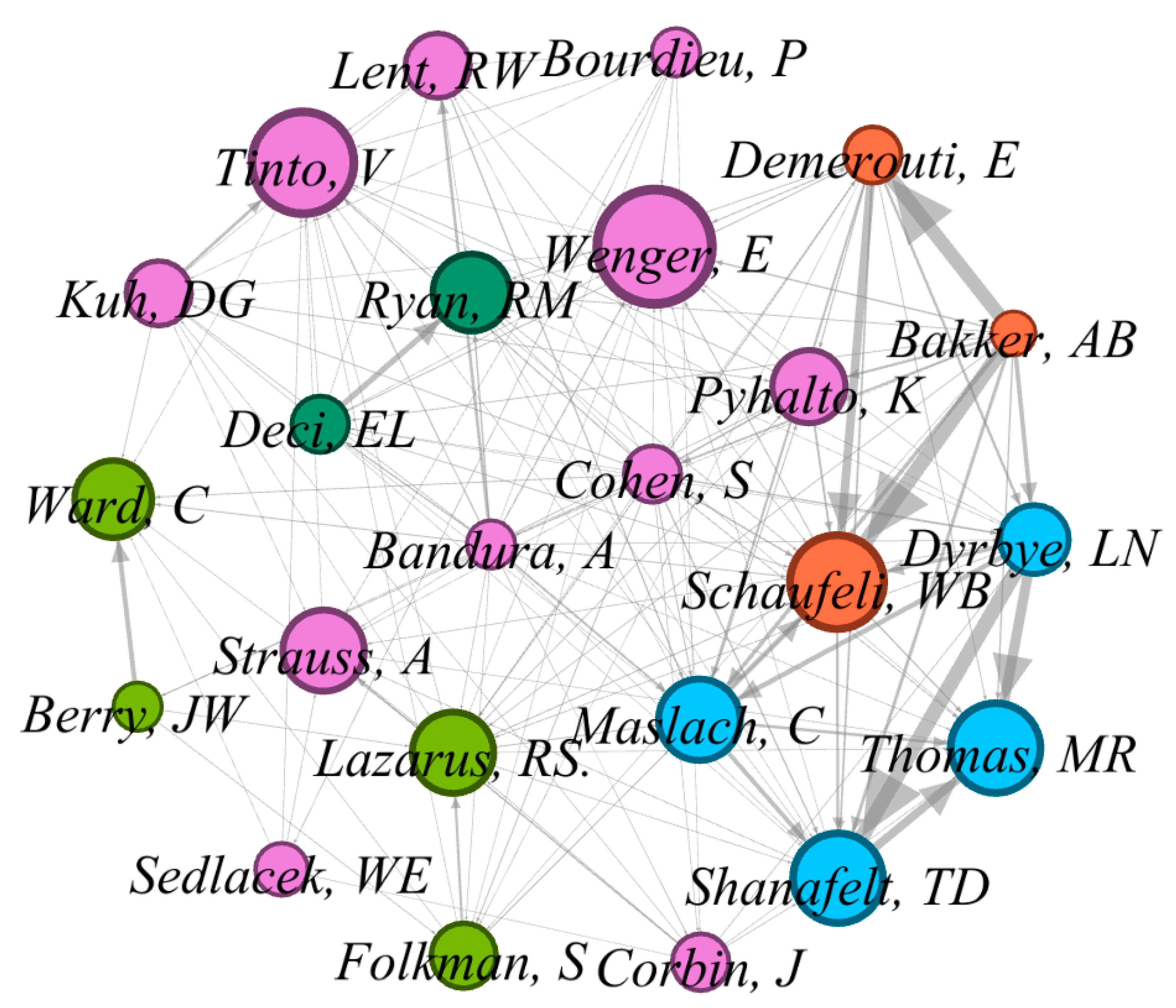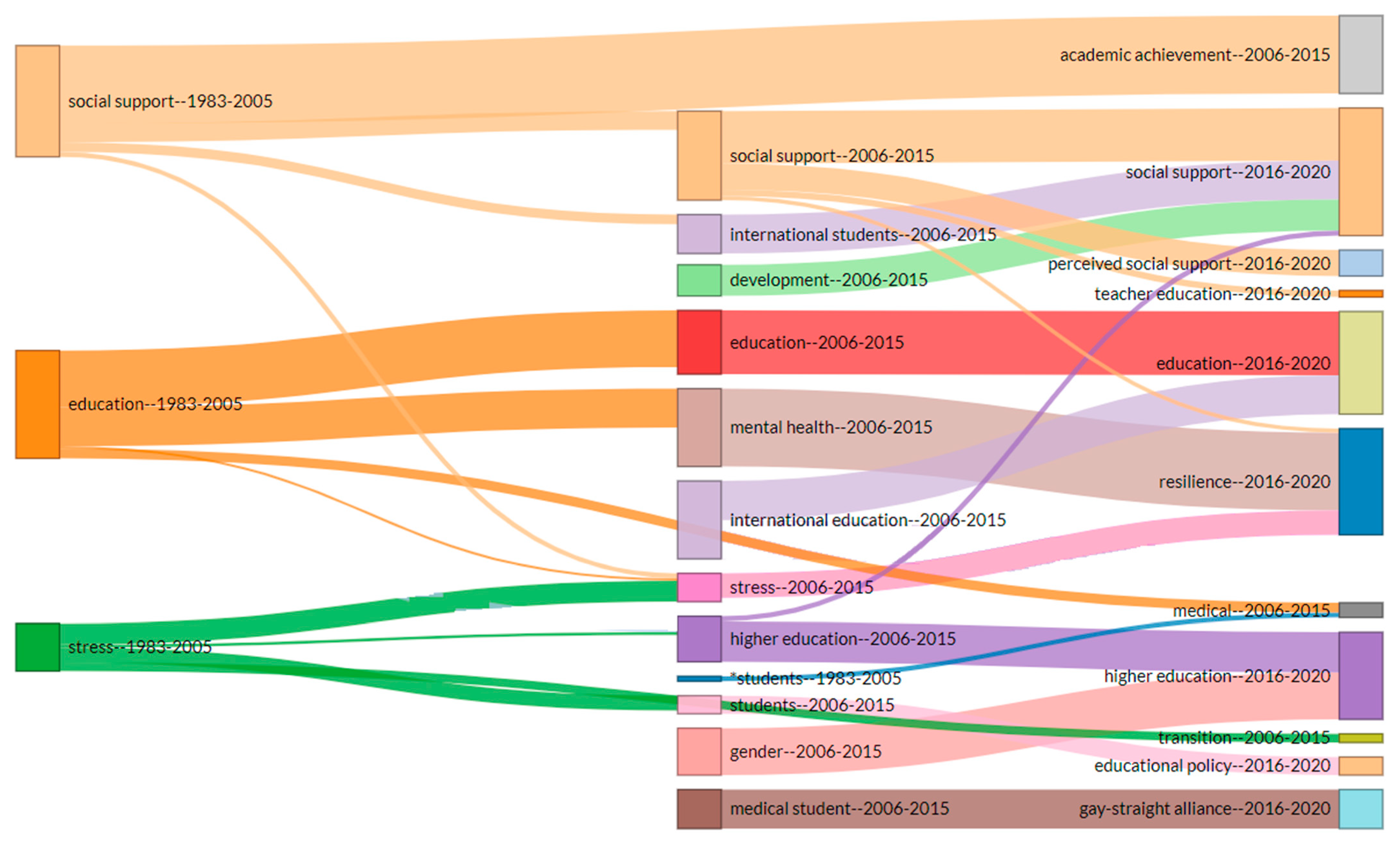A Scientometric Analysis of Forty-Three Years of Research in Social Support in Education (1977–2020)
Abstract
1. Introduction
- What are the publishing and citation structure in social support research in education from 1977 to 2020?
- Which of the countries, organizations, and authors are most productive in social support in education research?
- Which journals are frequently preferred by social support researchers?
- What are the authorship and collaborative patterns of researchers working on social support in education?
- What are most frequent keywords and major themes used in social support research in education?
- What kind of bibliographic coupling of countries, journals and authors exist in the social support research in education?
2. Methodology
2.1. Method
2.2. Database Selection
2.3. Search Query
2.4. Date of Data Extraction
2.5. Inclusion/Exclusion Criteria
2.6. Data Analysis
3. Results and Discussion
3.1. Research Productivity
3.2. Publishing and Citation Structure of Social Support in Education
3.3. Leading Countries and Institutions
3.4. Most Productive Authors
3.5. Most Influential Journals
3.6. Authorship Pattern
3.7. Keyword Co-Occurrences in Social Support
3.8. Major Themes in Social Support in Education
- P1 (1977–2000)
- Social Support (4), Medical (4), Education (3), Stress (3) and Undergraduate (3)
- P2 (2001–2010)
- Social Support (18), Education (8), Stress (7), Medical (5), and Higher Education (5)
- P3 (2011–2021)
- Social Support (75), Higher Education (42), Education (20), International Students (16), and Resilience (13)
3.9. Bibliographic Coupling of Countries
3.10. Bibliographic Coupling of Journals
3.11. Bibliographic Coupling of Authors
3.12. Co-Citation Network of Authors
3.13. Three-Factor Analysis (Countries, Keywords, and Journals)
4. Conclusions
Author Contributions
Funding
Institutional Review Board Statement
Informed Consent Statement
Acknowledgments
Conflicts of Interest
References
- Awang, M.M.; Kutty, F.M.; Ahmad, A.R. Perceived Social Support and Well Being: First-Year Student Experience in University. Int. Educ. Stud. 2014, 7, 261–270. [Google Scholar] [CrossRef]
- Tayfur, C.; Ulupinar, S. The Effect of Perceived Social Support on the Academic Achievement of Health College Students. J. Psychiatr. Nurs./Psikiyatr. Hemsireleri Dern. 2016, 7, 1–6. [Google Scholar] [CrossRef]
- Malecki, C.K.; Demary, M.K. Measuring perceived social support: Development of the child and adolescent social support scale (CASSS). Psychol. Sch. 2002, 39, 1–18. [Google Scholar] [CrossRef]
- Thoits, P.A. Life stress, social support, and psychological vulnerability: Epidemiological considerations. J. Community Psychol. 1982, 10, 341–362. [Google Scholar] [CrossRef]
- Adams, B.N. Interaction Theory and the Social Network. Sociometry 1967, 30, 64–78. [Google Scholar] [CrossRef]
- Cobb, S. Social support as a moderator of life stress. Psychosom. Med. 1976, 38, 300–314. [Google Scholar] [CrossRef]
- Cutrona, C.E.; Russell, D.W. Type of social support and specific stress: Toward a theory of optimal matching. In Social Support: An Interactional View; Wiley series on personality processes; John Wiley & Sons: Oxford, UK, 1990; pp. 319–366. [Google Scholar]
- Uchino, B.N. Social Support and Physical Health: Understanding the Health Consequences of Relationships; Yale University Press: New Haven, CT, USA, 2004. [Google Scholar]
- Wills, T.A. Social support and interpersonal relationships. In Prosocial Behavior; Review of personality and social psychology; Sage Publications, Inc.: Thousand Oaks, CA, USA, 1991; Volume 12, pp. 265–289. [Google Scholar]
- House, J.S.; Kahn, R.L.; McLeod, J.D.; Williams, D. Measures and concepts of social support. In Social Support and Health; Academic Press: San Diego, CA, USA, 1985; pp. 83–108. [Google Scholar]
- Langford, C.P.H.; Bowsher, J.; Maloney, J.P.; Lillis, P.P. Social support: A conceptual analysis. J. Adv. Nurs. 1997, 25, 95–100. [Google Scholar] [CrossRef]
- Demir, M.; Leyendecker, B. School-Related Social Support Is Associated With School Engagement, Self-Competence and Health-Related Quality of Life (HRQoL) in Turkish Immigrant Students. Front. Educ. 2018, 3. [Google Scholar] [CrossRef]
- Tian, L.; Tian, Q.; Huebner, E.S. School-Related Social Support and Adolescents’ School-Related Subjective Well-Being: The Mediating Role of Basic Psychological Needs Satisfaction at School. Soc. Indic. Res. 2016, 128, 105–129. [Google Scholar] [CrossRef]
- Vedder, P.; Boekaerts, M.; Seegers, G. Perceived social support and well being in school; The role of students’ ethnicity. J. Youth Adolesc. 2005, 34, 269–278. [Google Scholar] [CrossRef]
- Saylor, C.F.; Leach, J.B. Perceived bullying and social support in students accessing special inclusion programming. J. Dev. Phys. Disabil. 2009, 21, 69–80. [Google Scholar] [CrossRef]
- Fisher, S. Stress in Academic Life: The Mental Assembly Line; Open University Press: Maidenhead, UK, 1994; pp. xiii, 106. [Google Scholar]
- Tinto, V. Reconstructing the First Year of College. Plan. High. Educ. 1996, 25, 1–6. [Google Scholar]
- Marhamah, F.; Hamzah, H. The relationship between social support and academic stress among first year students at Syiah Kuala university. Psikoislamedia J. Psikol. 2017, 1, 149–171. [Google Scholar] [CrossRef]
- Hillman, K. The First Year Experience: The Transition from Secondary School to University and TAFE in Australia; 2005; p. 44. Available online: https://research.acer.edu.au/lsay_research/44 (accessed on 11 December 2020).
- Liu, W.; Mei, J.; Tian, L.; Huebner, E.S. Age and gender differences in the relation between school-related social support and subjective well-being in school among students. Soc. Indic. Res. 2016, 125, 1065–1083. [Google Scholar] [CrossRef]
- Wentzel, K.R.; Muenks, K.; McNeish, D.; Russell, S. Peer and teacher supports in relation to motivation and effort: A multi-level study. Contemp. Educ. Psychol. 2017, 49, 32–45. [Google Scholar] [CrossRef]
- Berndt, T.J. Friends’ influence on students’ adjustment to school. Educ. Psychol. 1999, 34, 15–28. [Google Scholar] [CrossRef]
- Wentzel, K.R. Social relationships and motivation in middle school: The role of parents, teachers, and peers. J. Educ. Psychol. 1998, 90, 202–209. [Google Scholar] [CrossRef]
- Driessen, G.; Withagen, V. Language Varieties and Educational Achievement of Indigenous Primary School Pupils. Lang. Cult. Curric. 1999, 12, 1–22. [Google Scholar] [CrossRef]
- Nickerson, A.B.; Nagle, R.J. Parent and peer attachment in late childhood and early adolescence. J. Early Adolesc. 2005, 25, 223–249. [Google Scholar] [CrossRef]
- Malecki, C.K.; Demaray, M.K. What Type of Support Do They Need? Investigating Student Adjustment as Related to Emotional, Informational, Appraisal, and Instrumental Support. Sch. Psychol. Q. 2003, 18, 231–252. [Google Scholar] [CrossRef]
- Bokhorst, C.L.; Sumter, S.R.; Westenberg, P.M. Social Support from Parents, Friends, Classmates, and Teachers in Children and Adolescents Aged 9 to 18 Years: Who Is Perceived as Most Supportive? Soc. Dev. 2010, 19, 417–426. [Google Scholar] [CrossRef]
- Malecki, C.K.; Demaray, M.K. Social support as a buffer in the relationship between socioeconomic status and academic performance. Sch. Psychol. Q. 2006, 21, 375–395. [Google Scholar] [CrossRef]
- Rueger, S.Y.; Malecki, C.K.; Demaray, M.K. Gender differences in the relationship between perceived social support and student adjustment during early adolescence. Sch. Psychol. Q. 2008, 23, 496–514. [Google Scholar] [CrossRef]
- Goebert, D. Social support, mental health, minorities, and acculturative stress. In Determinants of Minority Mental Health and Wellness; Loue, S., Sajatovic, M., Eds.; Springer: New York, NY, USA, 2009; pp. 125–148. [Google Scholar]
- Garcia-Reid, P.; Reid, R.J.; Peterson, N.A. School engagement among Latino youth in an urban middle school context:Valuing the role of social support. Educ. Urban Soc. 2005, 37, 257–275. [Google Scholar] [CrossRef]
- Shi, Y.; Sun, F.; Liu, Y.; Marsiglia, F.F. Perceived threat of Alzheimer’s disease and related dementias among older Chinese Americans in subsidized housing: Through a cultural lens. Dementia 2020, 19, 1777–1793. [Google Scholar] [CrossRef] [PubMed]
- Lee, K.; Lawton, C.; Boateng, A. Parental experiences for teenage mothers living in poverty: Associations of head start. Affilia 2020, 0886109920963032. [Google Scholar] [CrossRef]
- Nakagawa, T.; Hülür, G. Social Integration and Terminal Decline in Life Satisfaction Among Older Japanese. J. Gerontol. Ser. B 2019, 75, 2122–2131. [Google Scholar] [CrossRef]
- Rouse, H.L.; Hurt, T.R.; Melby, J.N.; Bartel, M.; McCurdy, B.; McKnight, E.; Zhao, F.; Behrer, C.; Weems, C.F. Pregnancy and Parenting Among Youth Transitioning from Foster Care: A Mixed Methods Study. Child Youth Care Forum 2021, 50, 167–197. [Google Scholar] [CrossRef]
- Agyekum, B.; Siakwah, P.; Boateng, J.K. Immigration, education, sense of community and mental well-being: The case of visible minority immigrants in Canada. J. Urban. Int. Res. Placemaking Urban Sustain. 2020, 1–15. [Google Scholar] [CrossRef]
- Macuka, I.; Tucak Junaković, I.; Božić, D. Burnout among Palliative Care Professionals. Društvena Istraživanja Časopis Za Opća Društvena Pitanja 2020, 29, 287–308. [Google Scholar] [CrossRef]
- Abt, H.A. Institutional productivities. PASP 1993, 105, 794–798. [Google Scholar] [CrossRef]
- Siddique, N.; Rehman, S.U.; Khan, M.A.; Altaf, A. Library and information science research in Pakistan: A bibliometric analysis, 1957–2018. J. Librariansh. Inf. Sci. 2020, 53, 89–102. [Google Scholar] [CrossRef]
- Tijjani, B.; Ashiq, M.; Siddique, N.; Khan, M.A.; Rasul, A. A bibliometric analysis of quality research papers in Islamic finance: Evidence from Web of Science. ISRA Int. J. Islamic Financ. 2020. ahead-of-print. [Google Scholar] [CrossRef]
- Ahmad, S.; Ur Rehman, S.; Ashiq, M. A Bibliometric Review of Arab World Research from 1980–2020. Sci. Technol. Libr. 2021, 1–21. [Google Scholar] [CrossRef]
- Gul, S.; Rehman, S.U.; Ashiq, M.; Khattak, A. Mapping the Scientific Literature on COVID-19 and Mental Health. Psychiatr. Danub. 2020, 32, 463–471. [Google Scholar] [CrossRef]
- Jabali, K.A.; Ashiq, M.; Ahmad, S.; Rehman, S.U. A Bibliometric Analysis of Research Productivity on Diabetes Modeling and Artificial Pancreas 2001 to 2020. Libr. Philos. Pract. 2020, 1–19. Available online: https://digitalcommons.unl.edu/libphilprac/4305/ (accessed on 11 December 2020).
- Baas, J.; Schotten, M.; Plume, A.; Côté, G.; Karimi, R. Scopus as a curated, high-quality bibliometric data source for academic research in quantitative science studies. Quant. Sci. Stud. 2020, 1, 377–386. [Google Scholar] [CrossRef]
- Mishra, S. Social networks, social capital, social support and academic success in higher education: A systematic review with a special focus on ‘underrepresented’ students. Educ. Res. Rev. 2020, 29, 100307. [Google Scholar] [CrossRef]
- Shu, F.; Ahmed, S.F.; Pickett, M.L.; Ayman, R.; McAbee, S.T. Social support perceptions, network characteristics, and international student adjustment. Int. J. Intercult. Relat. 2020, 74, 136–148. [Google Scholar] [CrossRef]
- Aparicio-Martinez, P.; Perea-Moreno, A.-J.; Martinez-Jimenez, M.P.; Redel-Macías, M.D.; Vaquero-Abellan, M.; Pagliari, C. A Bibliometric Analysis of the Health Field Regarding Social Networks and Young People. Int. J. Environ. Res. Public Health 2019, 16, 4024. [Google Scholar] [CrossRef]
- Saleem, F.; Khattak, A.; Ur Rehman, S.; Ashiq, M. Bibliometric Analysis of Green Marketing Research from 1977 to 2020. Publications 2021, 9, 1. [Google Scholar] [CrossRef]
- Muirhead, V.; Locker, D. Canadian dental students’ perceptions of stress and social support. Eur. J. Dent. Educ. 2008, 12, 144–148. [Google Scholar] [CrossRef] [PubMed]
- Park, K.H.; Kim, D.; Kim, S.K.; Yi, Y.H.; Jeong, J.H.; Chae, J.; Hwang, J.; Roh, H. The relationships between empathy, stress and social support among medical students. Int. J. Med. Educ. 2015, 6, 103–108. [Google Scholar] [CrossRef] [PubMed]
- Labrague, L.J.; De los Santos, J.A.A. COVID-19 anxiety among front-line nurses: Predictive role of organisational support, personal resilience and social support. J. Nurs. Manag. 2020, 28, 1653–1661. [Google Scholar] [CrossRef] [PubMed]
- Raza, A.; Matloob, S.; Abdul Rahim, N.F.; Abdul Halim, H.; Khattak, A.; Ahmed, N.H.; Nayab, D.-e.; Hakeem, A.; Zubair, M. Factors Impeding Health-Care Professionals to Effectively Treat Coronavirus Disease 2019 Patients in Pakistan: A Qualitative Investigation. Front. Psychol. 2020, 11. [Google Scholar] [CrossRef]
- Xiao, H.; Zhang, Y.; Kong, D.; Li, S.; Yang, N. The Effects of Social Support on Sleep Quality of Medical Staff Treating Patients with Coronavirus Disease 2019 (COVID-19) in January and February 2020 in China. Med. Sci. Monit. 2020, 26, e923549. [Google Scholar] [CrossRef] [PubMed]
- Grey, I.; Arora, T.; Thomas, J.; Saneh, A.; Tohme, P.; Abi-Habib, R. The role of perceived social support on depression and sleep during the COVID-19 pandemic. Psychiatry Res. 2020, 293, 113452. [Google Scholar] [CrossRef] [PubMed]
- Skalski, S.; Uram, P.; Dobrakowski, P.; Kwiatkowska, A. The link between ego-resiliency, social support, SARS-CoV-2 anxiety and trauma effects. Polish adaptation of the Coronavirus Anxiety Scale. Pers. Individ. Dif. 2021, 171, 110540. [Google Scholar] [CrossRef]
- Yu, H.; Li, M.; Li, Z.; Xiang, W.; Yuan, Y.; Liu, Y.; Li, Z.; Xiong, Z. Coping style, social support and psychological distress in the general Chinese population in the early stages of the COVID-19 epidemic. BMC Psychiatry 2020, 20, 426. [Google Scholar] [CrossRef]
- Sankar, J.; Kalaichelvi, R.; John, J.; Menon, N.; Elumalai, K.; Alqahtani, M.; Abumelha, M. Factors Affecting the Quality of E-Learning During the COVID-19 Pandemic from the Perspective of Higher Education Students. J. Inf. Technol. Educ. Res. 2020, 19, 731–753. [Google Scholar]










| PY | TP | TC | NCP | C/P | C/CP | H-Index |
|---|---|---|---|---|---|---|
| 1977 | 1 | 0 | 0 | 0.00 | 0 | 0 |
| 1983 | 1 | 4 | 1 | 4.00 | 4.00 | 1 |
| 1985 | 1 | 6 | 1 | 6.00 | 6.00 | 1 |
| 1987 | 3 | 17 | 2 | 5.67 | 8.50 | 2 |
| 1988 | 1 | 7 | 1 | 7.00 | 7.00 | 1 |
| 1989 | 2 | 46 | 2 | 23.00 | 23.00 | 2 |
| 1990 | 4 | 113 | 4 | 28.25 | 28.25 | 4 |
| 1991 | 5 | 64 | 4 | 12.80 | 16.00 | 4 |
| 1992 | 4 | 26 | 4 | 6.50 | 6.50 | 3 |
| 1993 | 2 | 25 | 2 | 12.50 | 12.50 | 2 |
| 1994 | 3 | 221 | 3 | 73.67 | 73.67 | 3 |
| 1995 | 3 | 1002 | 3 | 334.00 | 334.00 | 2 |
| 1996 | 2 | 31 | 2 | 15.50 | 15.50 | 2 |
| 1997 | 1 | 24 | 1 | 24.00 | 24.00 | 1 |
| 1998 | 2 | 46 | 2 | 23.00 | 23.00 | 2 |
| 1999 | 2 | 33 | 2 | 16.50 | 16.50 | 2 |
| 2000 | 4 | 86 | 3 | 21.50 | 28.67 | 2 |
| 2001 | 3 | 440 | 3 | 146.67 | 146.67 | 3 |
| 2002 | 6 | 165 | 6 | 27.50 | 27.50 | 6 |
| 2003 | 4 | 123 | 4 | 30.75 | 30.75 | 4 |
| 2004 | 12 | 619 | 11 | 51.58 | 56.27 | 11 |
| 2005 | 9 | 603 | 9 | 67.00 | 67.00 | 8 |
| 2006 | 13 | 326 | 13 | 25.08 | 25.08 | 9 |
| 2007 | 9 | 539 | 8 | 59.89 | 67.38 | 8 |
| 2008 | 23 | 439 | 20 | 19.09 | 21.95 | 12 |
| 2009 | 22 | 684 | 21 | 31.09 | 32.57 | 12 |
| 2010 | 18 | 539 | 17 | 29.94 | 31.71 | 13 |
| 2011 | 22 | 366 | 19 | 16.64 | 19.26 | 9 |
| 2012 | 21 | 404 | 21 | 19.24 | 19.24 | 10 |
| 2013 | 31 | 370 | 27 | 11.94 | 13.70 | 14 |
| 2014 | 35 | 351 | 31 | 10.03 | 11.32 | 11 |
| 2015 | 31 | 369 | 29 | 11.90 | 12.72 | 12 |
| 2016 | 36 | 411 | 30 | 11.42 | 13.70 | 10 |
| 2017 | 50 | 377 | 40 | 7.54 | 9.43 | 12 |
| 2018 | 48 | 264 | 40 | 5.50 | 6.60 | 8 |
| 2019 | 52 | 83 | 29 | 1.60 | 2.86 | 4 |
| 2020 | 57 | 47 | 12 | 0.82 | 3.92 | 5 |
| 2021 | 2 | 0 | 0 | 0.00 | 0.00 | 0 |
| Top 10 Countries | Top 10 Organizations | ||||||||
|---|---|---|---|---|---|---|---|---|---|
| Rank | Country | TP | TC | CI | Rank | Organization | TP | TC | CI |
| 1 | United States | 194 | 3392 | 17.48 | 1 | The University of Texas at Austin | 10 | 230 | 23.00 |
| 2 | United Kingdom | 56 | 1377 | 24.59 | 2 | Maastricht University | 7 | 57 | 8.14 |
| 3 | Australia | 50 | 581 | 11.62 | 3 | University of Illinois at Chicago | 7 | 116 | 16.57 |
| 4 | Canada | 31 | 957 | 30.87 | 4 | University of Florida | 6 | 48 | 8.00 |
| 5 | Germany | 25 | 303 | 12.12 | 5 | Humboldt University of Berlin | 5 | 123 | 24.60 |
| 6 | Turkey | 21 | 86 | 4.10 | 6 | University of Helsinki | 5 | 74 | 14.80 |
| 7 | Netherlands | 17 | 292 | 17.18 | 7 | University of Antwerp | 5 | 121 | 24.20 |
| 8 | Spain | 15 | 40 | 2.67 | 8 | The Education University of Hong Kong | 5 | 21 | 4.20 |
| 9 | South Africa | 13 | 42 | 3.23 | 9 | University of New South Wales, Sydney, Australia | 5 | 101 | 20.20 |
| 10 | Israel | 9 | 124 | 13.78 | 10 | Florida State University | 5 | 24 | 4.80 |
| Rank | Authors | Affiliation | Country | TP | TC | CPY | h-Index |
|---|---|---|---|---|---|---|---|
| 1 | Pyhältö, K. | University of Oulu | Finland | 5 | 74 | 14.80 | 5 |
| 2 | Ramos-Díaz, E. | The University of the Basque Country | Spain | 3 | 17 | 5.67 | 3 |
| 3 | Soini, T. | University of Tampere | Finland | 3 | 53 | 17.67 | 3 |
| 4 | Pietarinen, J. | University of Eastern Finland | Finland | 3 | 53 | 17.67 | 3 |
| 5 | Bodycott, P. | University of Canberraact | Australia | 3 | 23 | 7.67 | 2 |
| 6 | Gijbels, D. | University of Antwerp | Belgium | 3 | 43 | 14.33 | 2 |
| 7 | Mak, A.S. | University of Canberraact | Australia | 3 | 23 | 7.67 | 2 |
| 8 | Yu, B. | The Education University of Hong Kong | Hong Kong | 3 | 7 | 2.33 | 1 |
| 9 | Cunningham, M. | Tulane University, New Orleans | United States | 2 | 45 | 22.50 | 2 |
| 10 | Jaarsma, A.D.C. | University Medical Center Groningen | Netherlands | 2 | 21 | 10.50 | 2 |
| Rank | Journal | TP | TC | IF | Q | Publisher | Country |
|---|---|---|---|---|---|---|---|
| 1 | Academic Medicine | 30 | 1235 | 5.354 | 1 | Lippincott Williams & Wilkins | United States |
| 2 | BMC Medical Education | 30 | 565 | 1.831 | 2 | Biomed Central Ltd. | England |
| 3 | Medical Teacher | 30 | 663 | 2.654 | 1 | Taylor & Francis Ltd. | England |
| 4 | Medical Education | 29 | 1228 | 4.57 | 1 | Wiley-Blackwell Publishing Ltd. | England |
| 5 | Journal of Studies in International Education | 9 | 171 | 2.148 | 2 | Sage Publications Inc | United States |
| 6 | Studies in Higher Education | 8 | 513 | 3 | 1 | Routledge Journals, Taylor & Francis Ltd. | England |
| 7 | Advances in Health Sciences Education | 8 | 125 | 2.48 | 1 | Springer | Netherlands |
| 8 | Social Work Education | 7 | 136 | N.A | 2 | Taylor and Francis Ltd. | England |
| 9 | Medical Education Online | 7 | 92 | 1.97 | 2 | Co-Action Publishing | Sweden |
| 10 | Teaching and Learning in Medicine | 7 | 118 | 1.848 | 2 | Taylor & Francis Ltd. | United States |
| SR. | Themes | TP | TC | C/P | P1 | P2 | P3 |
|---|---|---|---|---|---|---|---|
| 1977–2000 | 2001–2010 | 2011–2021 | |||||
| 1. | Social Support | 97 | 921 | 9.49 | 4 | 18 | 75 |
| 2. | Higher Education | 47 | 362 | 7.70 | 0 | 5 | 42 |
| 3. | Education | 31 | 966 | 31.16 | 3 | 8 | 20 |
| 4. | Stress | 20 | 363 | 18.15 | 3 | 7 | 10 |
| 5. | International Students | 17 | 155 | 9.12 | 0 | 1 | 16 |
| 6. | Burnout | 14 | 217 | 15.50 | 1 | 2 | 11 |
| 7. | Resilience | 13 | 155 | 11.92 | 0 | 0 | 13 |
| 8. | Students | 13 | 188 | 14.46 | 2 | 2 | 9 |
| 9. | Medical | 11 | 751 | 68.27 | 4 | 5 | 2 |
| 10. | Medical Education | 11 | 89 | 8.09 | 0 | 0 | 11 |
| 11. | Mental Health | 9 | 177 | 19.67 | 0 | 2 | 7 |
| 12. | Self-Efficacy | 9 | 168 | 18.67 | 0 | 1 | 8 |
| 13. | Social Capital | 8 | 93 | 11.63 | 0 | 2 | 6 |
| 14. | Social Networks | 8 | 83 | 10.38 | 0 | 3 | 5 |
| 15. | Teacher Education | 8 | 95 | 11.88 | 0 | 0 | 8 |
| 16. | Perceived Social Support | 7 | 67 | 9.57 | 0 | 0 | 7 |
| 17. | Medical Students | 7 | 84 | 12.00 | 0 | 1 | 6 |
| 18. | Gender | 7 | 70 | 10.00 | 0 | 0 | 7 |
| 19. | Social Work Education | 7 | 83 | 11.86 | 0 | 3 | 4 |
| 20. | Undergraduate | 7 | 65 | 9.29 | 3 | 1 | 3 |
Publisher’s Note: MDPI stays neutral with regard to jurisdictional claims in published maps and institutional affiliations. |
© 2021 by the authors. Licensee MDPI, Basel, Switzerland. This article is an open access article distributed under the terms and conditions of the Creative Commons Attribution (CC BY) license (http://creativecommons.org/licenses/by/4.0/).
Share and Cite
Rashid, S.; Rehman, S.U.; Ashiq, M.; Khattak, A. A Scientometric Analysis of Forty-Three Years of Research in Social Support in Education (1977–2020). Educ. Sci. 2021, 11, 149. https://doi.org/10.3390/educsci11040149
Rashid S, Rehman SU, Ashiq M, Khattak A. A Scientometric Analysis of Forty-Three Years of Research in Social Support in Education (1977–2020). Education Sciences. 2021; 11(4):149. https://doi.org/10.3390/educsci11040149
Chicago/Turabian StyleRashid, Shaista, Shafiq Ur Rehman, Murtaza Ashiq, and Amira Khattak. 2021. "A Scientometric Analysis of Forty-Three Years of Research in Social Support in Education (1977–2020)" Education Sciences 11, no. 4: 149. https://doi.org/10.3390/educsci11040149
APA StyleRashid, S., Rehman, S. U., Ashiq, M., & Khattak, A. (2021). A Scientometric Analysis of Forty-Three Years of Research in Social Support in Education (1977–2020). Education Sciences, 11(4), 149. https://doi.org/10.3390/educsci11040149








